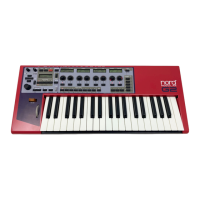11. Module reference: Shaper group NORD MODULAR G2 V1.1
Page 150
O
OO
O
V
VV
VE
EE
ER
RR
RD
DD
DR
RR
RI
II
IV
VV
VE
EE
E
Sets the initial overdrive amount. See also "Common Shaper parameters”.
S
SS
S
A
AA
AT
TT
TU
UU
UR
RR
RA
AA
AT
TT
TE
EE
E
This module shapes an input signal in a
logarithmic fashion. You can choose be-
tween four different transformation
curve characteristics.
C
CC
C
U
UU
UR
RR
RV
VV
VE
EE
E
Choose between four different transformation curve characteristics. Curve 1 is a smooth logarithmic
transformation and Curve 4 is a hard transformation.
A
AA
A
M
MM
MO
OO
OU
UU
UN
NN
NT
TT
T
Sets the initial shape amount. See also "Common Shaper parameters”.
S
SS
S
H
HH
HP
PP
P
E
EE
E
X
XX
XP
PP
P
This module shapes an input signal in an
exponential fashion. You can choose be-
tween four different transformation
curve characteristics.
C
CC
C
U
UU
UR
RR
RV
VV
VE
EE
E
Choose between four different transformation curve characteristics. Curve x2 is a smooth exponential
transformation and Curve x5 is a hard transformation.
A
AA
A
M
MM
MO
OO
OU
UU
UN
NN
NT
TT
T
Sets the initial shape amount. See also "Common Shaper parameters”.
W
WW
W
A
AA
AV
VV
VE
EE
E
W
WW
W
R
RR
RA
AA
AP
PP
PP
PP
PE
EE
ER
RR
R
This module amplifies a signal until it
hits the headroom. Instead of clipping
the signal, it folds down, “wraps
around". The waveform of the signal
will be heavily transformed, with a lot of new overtones, which gives it distortion- and/or FM-like char-
acteristics.
W
WW
W
R
RR
RA
AA
AP
PP
P
Sets the initial wrap amount. See also "Common Shaper parameters”.
S
SS
S
H
HH
HP
PP
P
S
SS
S
T
TT
TA
AA
AT
TT
TI
II
IC
CC
C
This module transforms a signal using
one of four different amplification/at-
tenuation characteristics. The curves on
the buttons describes the transformation
functions, i.e the amplification/attenuation of each value of the input signal.

